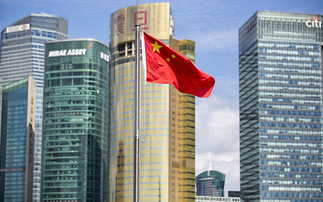China's consumers celebrated their first major national holiday since the Covid-19 pandemic brought domestic travel to a standstill in February. A daily average of 23 million people travelled in the five-day May Day holiday, down by around 50% from the same period in 2019, according to the Ministry of Culture and Tourism. Despite the year-on-year drop, it's a great improvement from February and March, when most of China was locked down due to the coronavirus outbreak. Even a few weeks ago, a three-day weekend in early April saw only around 14 million daily domestic travellers.
It's worth noting that tourism demand has been partially curbed by tough crowd control measures to reduce infection risks. The ministry ordered scenic park operators to cap visitation at 30% of their capacity during the May holiday.
Pent-up demand
International travel remains off the menu, but clear indications of a gradual recovery in domestic Chinese tourism could offer a dose of encouragement to other countries looking ahead to life after lockdowns, including the slow release of pent-up demand among consumers.
An average tourist spent some 414 renminbi (around US$58) a day in the May break, down 31% from a year ago. Still, the per capita spending is more than double that for the 4-6 April long weekend. Total tourism revenue came in at 47.6bn renminbi for the five days, less than half of the 2019 May holiday amount.
Tourism showing signs of recovery
Source: Ministry of Culture and Tourism, Fidelity International, 7 May 2020.
Planes and trains rebound
While many airlines around the world remain effectively grounded, China's commercial carriers are staging a tentative rebound. Daily air passengers have more than quadrupled since mid-February to about 780,000 on 5 May. Similarly, the number of railway travellers has risen to about six million a day from less than one million over the same period.
Travellers climb as lockdown ends
Source: Ministry of Transport, Fidelity International, 7 May 2020.
Chinese airlines have generally resumed operations at about 50% of their capacity, far above levels between 10% to 30% for many global peers. Financially, they also fare much better than Western commercial carriers, some of which are counting on government bailouts to survive. Large Chinese airlines show relatively strong balance sheets without any immediate liquidity problems (having the state as a major shareholder provides extra reassurance).
The historic crash of oil prices should benefit most Chinese carriers, as they have little to no jet fuel hedges in their books. Fuel accounts for about 30% of their cost base.
However, challenges remain for Chinese airlines despite the improvement. International flights have almost completely collapsed, while domestically, business travel is minimal. Forward bookings indicate that a recovery in demand remains slow, with low visibility beyond the very near-term.
Hotel rooms
The epidemic plunged hotel occupancy rates to single digits in February, but they have since bounced back to around 50%, based on our checks with operators and industry experts.
Mid-market hotels are faring better than both high-end and low-end properties. A lack of business or international travellers has curbed demand for luxury hotels; Chinese consumers could also be tightening their budgets. Price cuts have become the order of the day, with some five-star properties in Shanghai offering 50% discounts. The cheapest hotels, on the other hand, have struggled due to popular impressions they could put less focus on cleanliness.
Trip bookings
Travel bookings have returned to about 60% of normal levels, although tour companies are giving large discounts to keep business going. For example, Shenzhen's well-known Happy Valley theme park is offering annual passes for 365 renminbi each, compared to a previous single-visit ticket for 220 renminbi.
So far, Chinese travellers are still showing a cautious preference for short distance trips. People feel relieved that they have come out of the worst, but it's unrealistic to expect a V-shaped rebound. We will likely see a gradual recovery first in domestic tourism, followed by short-haul regional travel where the virus is well contained. But visibility remains low for the normalisation of long-haul international travel.
What will it take for China tourism to make a full recovery? Seeing tourism as a key part of domestic consumption, Chinese policymakers have rolled out stimulus to support the industry. Tourist vouchers are being distributed in various provinces, where travellers can use them to pay for sightseeing, dining and shopping. City officials in Huzhou in eastern Zhejiang province, for instance, have distributed vouchers worth over 200 million renminbi to tourists since March.
More importantly, the pace of recovery will depend on the confidence of Chinese consumers about their jobs and income growth. China has so far avoided large-scale job losses in the pandemic, but it remains to be seen how it will cope with a slump in global demand for Chinese goods. Travel can be highly discretionary for middle-class Chinese consumers, although it's not as big an outlay as housing or education. Going forward, data on employment, household income and corporate credit default rates will be key to watch.
Further information
Fidelity China Consumer Fund W-ACC-GBP
This information is for investment professionals only and should not be relied upon by private investors.
This information is for investment professionals only and should not be relied upon by private investors. The ideas and conclusions here do not necessarily reflect the views of Fidelity's portfolio managers and are for general interest only. Investors should note that the views expressed may no longer be current and may have already been acted upon. Reference to specific securities should not be interpreted as a recommendation to buy or sell these securities but is included for the purposes of illustration only. The Fidelity China Consumer Fund can use financial derivatives which may expose it to a higher degree of risk and can cause investments to experience larger than average price fluctuations. Changes in currency exchange rates may affect the value of an investment in overseas markets. Investments in small and emerging markets can also be more volatile than other more developed markets. Investments should be made on the basis of the current prospectus, which is available along with the Key Investor Information Document and current and semi-annual reports, free of charge on request, by calling 0800 368 1732. Issued by Financial Administration Services Limited and FIL Pensions Management, authorised and regulated by the Financial Conduct Authority. Fidelity, Fidelity International, the Fidelity International logo and F symbol are trademarks of FIL Limited. ED20 - 155













